Manual stitch functionality on a sewing machine embodies the essence of artisanal craftsmanship in the realm of textile creation.
It signifies the art of sewing at its most hands-on, where the operator assumes direct control over the stitching process.
Unlike automated or computerized modes, manual stitching empowers users with the ability to dictate every nuance of their stitches – from length and width to style and intricacy.
This tactile approach enables crafters to achieve unparalleled precision, making it indispensable for intricate embroidery, delicate fabric handling, buttonhole creation, and free-motion artistic expression.
In this realm, the sewing machine becomes a versatile tool, adaptable to a multitude of creative endeavors and bespoke tailoring tasks.
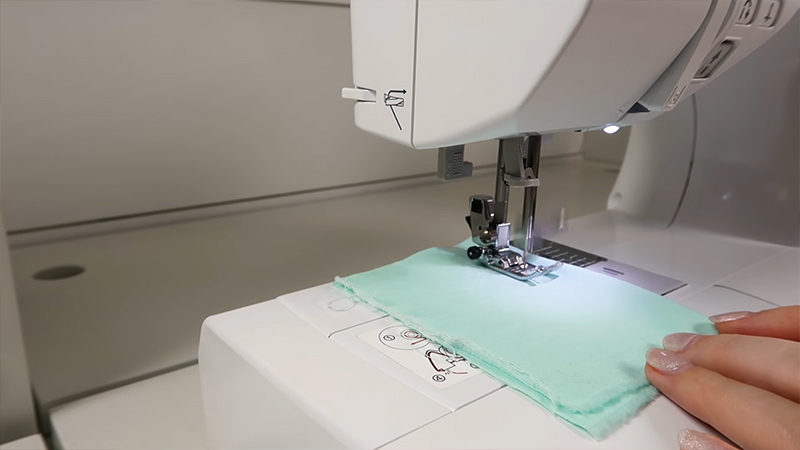
What Does Manual Stitch Mean on a Sewing Machine?
Manual stitch on a sewing machine refers to the process of controlling the machine’s stitching mechanism by hand, as opposed to relying on automated or pre-programmed stitching patterns.
In a traditional sewing machine, the manual stitch function allows the user to have complete control over the length, width, and style of stitches produced.
This feature is particularly important for sewers and crafters who require precise and customizable stitching for their projects.
Here are some key aspects of manual stitching on a sewing machine:
Stitch Length
With manual stitching, you can adjust the length of each stitch to suit the specific requirements of your project. Shorter stitches are typically used for delicate fabrics or when added strength is needed, while longer stitches are ideal for decorative stitching or basting.
Stitch Width
Some sewing machines also allow you to adjust the width of certain stitches. This feature is particularly useful when creating decorative or zigzag stitches, as it allows you to control the width of the stitch pattern.
Stitch Selection
Manual stitch selection allows you to choose from various basic stitch styles, such as straight stitch, zigzag stitch, or overlock stitch, depending on your project’s needs. You can manually switch between these stitches while sewing.
Feed Dogs
The feed dogs are the toothed metal plates under the presser foot that move the fabric forward as you sew. In manual stitching, you can control the fabric’s movement by adjusting the speed and direction of your hand movements while guiding the fabric.
This gives you more control over the sewing process and allows you to create intricate designs or follow curves with precision.
Free-Motion Embroidery
Manual stitching is crucial for free-motion embroidery or quilting. In this technique, you can drop or cover the feed dogs and use an embroidery or darning foot to move the fabric freely in any direction. This allows you to create intricate and artistic designs that require precise control.
Buttonholes
Manual stitching is often used for creating buttonholes. Most sewing machines have a manual buttonhole setting that allows you to set the desired length and width for the buttonhole and manually guide the fabric along the template.
Repair and Alterations
Manual stitching is indispensable for sewing repairs or alterations on garments. When matching existing stitching or making small repairs, manual control ensures a seamless finish.
Types of Manual Stitches
Manual stitches are a crucial part of sewing and can be used for various purposes in both fashion and home sewing projects.
Here are the common types of manual stitches:
Straight Stitch
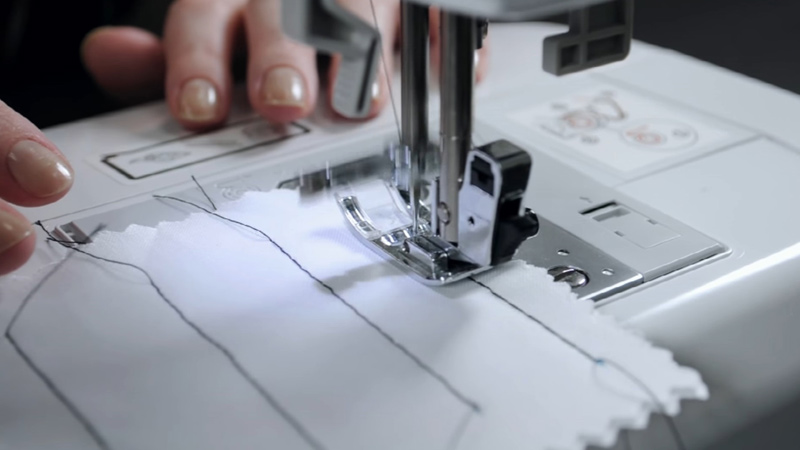
This is the basic and most commonly used stitch in sewing. It involves sewing in a straight line from one point to another. It can be used for joining fabric pieces, topstitching, and creating seams.
Backstitch
The backstitch is a strong and durable stitch used at the beginning and end of seams to secure them. It involves sewing backward and then forward in a straight line to lock the stitches.
Running Stitch
A running stitch is a basic hand-sewing stitch where the needle and thread pass in and out of the fabric in a straight line. It’s often used for gathering fabric or basting.
Basting Stitch
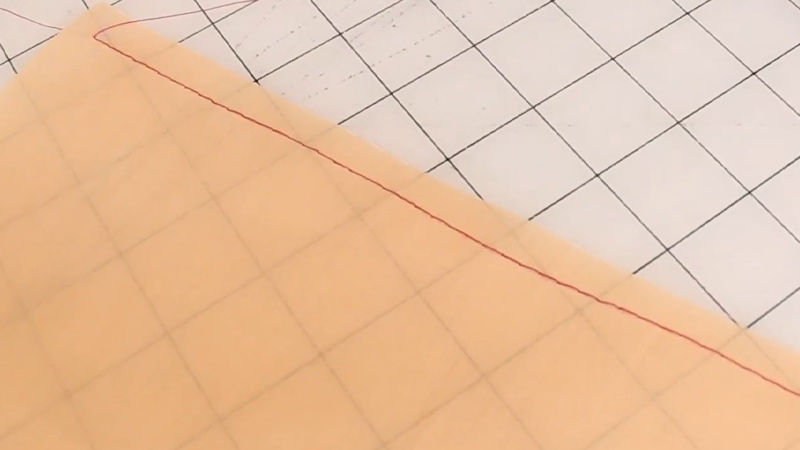
Basting stitches are long, temporary stitches used to hold fabric layers together for fitting or before final sewing. They are easy to remove once the permanent stitching is done.
Whipstitch
This is an overcasting stitch used to join two pieces of fabric or to finish the raw edges of the fabric. It creates a line of stitching that goes over the edge of the fabric.
Blind Stitch (Slip Stitch)
A blind stitch is often used for invisible hems. It involves sewing through the fold of the fabric and catching only a small amount of the fabric on the right side, creating nearly invisible stitches.
Hemming Stitch
Hemming stitches are used to create neat and secure hems on garments or other fabric items. Various hemming stitches include the catch stitch and the slip hem stitch.
Cross-Stitch
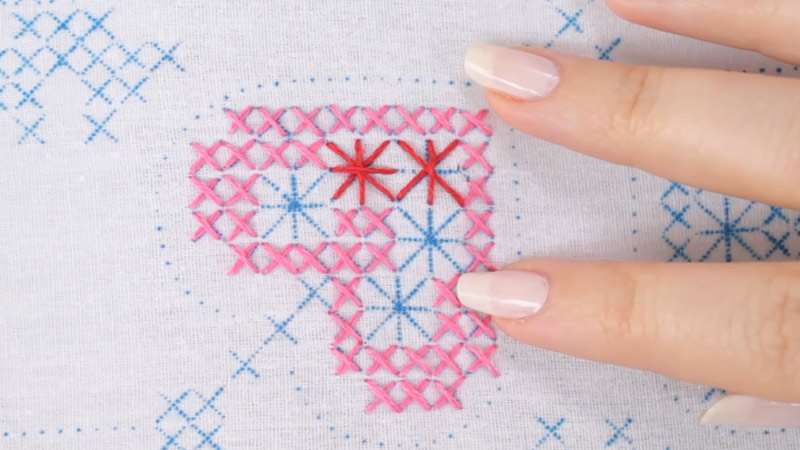
Cross-stitch is a decorative hand-sewing technique often used in embroidery. It creates an “X” pattern on fabric and is used to create intricate designs.
Blanket Stitch
Blanket stitch is commonly used for finishing the edges of blankets and other fabric items. It creates a neat, decorative edge that helps prevent fraying.
Buttonhole Stitch
Buttonhole stitches are used to create reinforced openings for buttons on garments. There are various types of buttonhole stitches, including the satin stitch and the keyhole stitch.
Embroidery Stitches
Embroidery encompasses a wide variety of decorative stitches, including satin stitch, chain stitch, stem stitch, and many others. These stitches are used for embellishing fabric with intricate designs and patterns.
Overlock Stitch
While typically done by a sewing machine, an overlock stitch can also be replicated by hand with a zigzag stitch or by using a specialized overlock hand-sewing technique. It’s used for finishing raw edges and preventing fraying.
When to Use Manual Stitches?
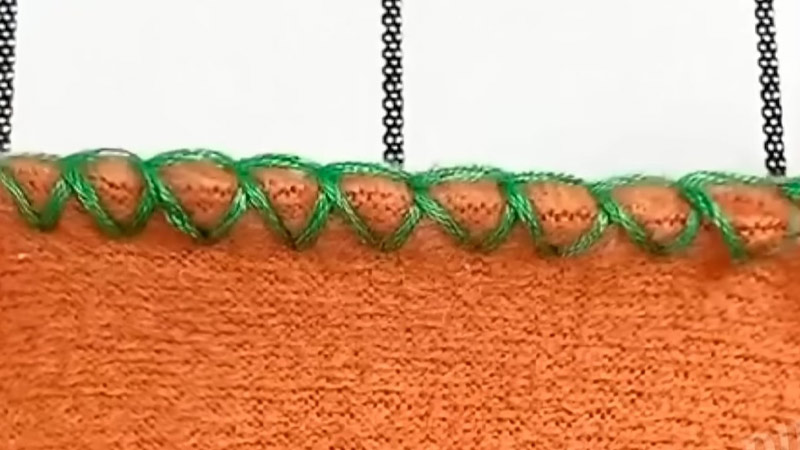
Manual stitches are an important part of sewing, and knowing when to use them is crucial for achieving the best results in your projects.
Here are some common situations when manual stitches are preferred:
Precision Sewing
When you need precise control over the stitching, especially in intricate or detailed work, manual stitches are the way to go. Hand sewing allows you to make tiny, precise stitches that can’t always be replicated by a sewing machine.
Reinforcing Seams
Manual stitches are great for reinforcing seams in areas that receive a lot of stress, such as crotch seams in pants, pocket corners, or underarm seams in garments. Adding hand stitches can provide extra durability.
Finishing Edges
To prevent fabric fraying and create a clean, polished look, manual stitches like overcasting or blanket stitches are used to finish raw fabric edges.
Hand Applique
When attaching small fabric pieces or appliqués to a larger background, manual stitches provide greater control and precision. The stitches can be hidden or used decoratively.
Buttonholes
Hand-sewn buttonholes can be more secure and customized to the size of your buttons. They are often used for delicate fabrics or when a decorative touch is desired.
Mending and Repairs
Manual stitches are perfect for repairing clothing, fixing small tears, and reattaching buttons. They offer a more discreet and controlled repair compared to machine stitches.
Quilting
Hand quilting allows for more intricate and artistic designs on quilts. The hand-stitched quilting lines can add texture and dimension to the quilt top.
Embroidery and Decorative Stitching
Hand embroidery relies entirely on manual stitches to create intricate patterns and designs. Different hand embroidery stitches can be used for various decorative effects.
Creating Unique Details
Hand stitches can be used to add unique and personalized details to your sewing projects, such as decorative embroidery, custom labels, or monograms.
Gathering Fabric
For controlled and even gathering of fabric, basting or running stitches are often used. This is useful in projects like ruffles or gathered skirts.
Securing Fasteners
Manual stitches are used to secure various fasteners, such as snaps, hooks eyes, and toggles. Hand-stitched fasteners can be more discreet and durable.
Complex Fabrics
When working with delicate or complex fabrics like lace, silk, or sheer materials, manual stitches allow you to handle the fabric gently and prevent damage.
Fitting Adjustments
Hand basting or tacking stitches are often used for fitting adjustments in garments. They can be easily removed if further adjustments are needed.
Advantages and Disadvantages of Manual Stitch
Manual stitching refers to the process of joining together pieces of fabric or materials using hand-operated sewing techniques, such as needle and thread, rather than using a sewing machine.
While manual stitching has been used for centuries and is still employed in various situations today, it comes with its own set of advantages and disadvantages:
Advantages of Manual Stitching:
- Precision and Control: Manual stitching allows for finer control over the stitching process, which can be advantageous when working on delicate or intricate projects. It’s easier to make small, precise stitches by hand.
- Portability: Manual stitching can be done anywhere, making it a portable and convenient option for mending or sewing on the go.
- Cost-Effective: You don’t need to invest in a sewing machine or electricity to perform manual stitching, which makes it a cost-effective option for those on a tight budget.
- Versatility: Manual stitching is versatile and can be used for various types of projects, including clothing repairs, embroidery, quilting, and handicrafts.
- Learning Opportunity: Learning to stitch by hand can be a valuable skill, and it provides a solid foundation for understanding sewing techniques and principles.
- Low Maintenance: Unlike sewing machines, which require regular maintenance and occasional repairs, manual stitching tools are relatively low maintenance.
Disadvantages of Manual Stitching:
- Time-Consuming: Manual stitching is generally slower than using a sewing machine, making it less efficient for large-scale or time-sensitive projects.
- Fatigue: Extended periods of manual stitching can lead to hand and wrist fatigue or discomfort, which may limit the amount of work that can be accomplished in a single session.
- Limited Stitch Options: Manual stitching offers a limited range of stitches compared to sewing machines, which can produce various types of stitches, including zigzag, straight, and decorative stitches.
- Inconsistency: Achieving consistent stitch lengths and tension by hand can be challenging, especially for beginners, leading to uneven results.
- Not Suitable for Heavy Fabrics: Manual stitching may not be the best choice for heavy or thick materials, as it can be difficult to penetrate and manipulate such fabrics with hand-operated tools.
- Skill Required: Achieving professional-quality results with manual stitching requires practice and skill, and beginners may initially produce less polished work.
Tips for Mastering Manual Stitches
Mastering manual stitches in sewing and needlework takes practice and patience.
Here are some tips to help you improve your skills:
Use the Right Needle and Thread
Select a needle and thread appropriate for your fabric and project. Thinner needles and threads work well for lightweight fabrics, while thicker ones are better for heavier materials.
Thread Tension
Maintain consistent thread tension. Avoid pulling the thread too tightly, as it can distort the fabric, and don’t leave it too loose, as it may result in loose stitches.
Practice Regularly
Like any skill, practice is key. Spend time practicing various stitches on scrap fabric before working on your actual project. This helps you get comfortable with the motions and the feel of the fabric.
Proper Hand Position
Maintain proper hand positioning while stitching. Your dominant hand should hold the needle while the non-dominant hand guides the fabric. This helps with control and accuracy.
Steady Pacing
Develop a steady and even stitching pace. Consistent stitch length and spacing make your work look more professional.
Knotting
Secure your thread by making small knots at the end or using a backstitch. This prevents your stitches from unraveling.
Thimble Use
Consider using a thimble to push the needle through the fabric. It protects your finger and helps you apply even pressure, especially when working with thick or tough materials.
Relax
Keep your hands and shoulders relaxed while sewing. Tension can affect the quality of your stitches.
Good Lighting
Adequate lighting is essential for precision. Make sure you have good lighting to see your stitches clearly, especially when working with fine details.
Sharp Tools
Use sharp scissors or snips to cut threads. Dull tools can lead to frayed threads and uneven cuts.
Marking and Measuring
Use fabric markers or chalk to mark your sewing lines and measurements accurately. This ensures that your stitches follow the desired path.
Pressing
Iron your fabric before and during the sewing process to eliminate wrinkles and make it easier to sew accurately.
Consistency
Pay attention to consistency in your stitches. Even if your stitches aren’t perfect, they should be uniform for a neater overall appearance.
Take Breaks
Sewing for extended periods can lead to fatigue and mistakes. Take short breaks to rest your eyes and hands.
Learn from Mistakes
Don’t be discouraged by mistakes. They are opportunities to learn and improve your skills. If you make an error, take the time to fix it before moving forward.
Seek Guidance
If you’re struggling with a particular stitch or technique, seek guidance from experienced sewers, join a sewing class, or watch tutorials online.
Stay Organized
Keep your sewing area organized to avoid losing tools, needles, or thread. Being organized will save you time and frustration.
Experiment
Don’t be afraid to experiment with different stitches and techniques. Trying new things will help you expand your skill set.
FAQS
What is a manual sewing machine?
A manual sewing machine is a traditional sewing machine operated entirely by hand. It lacks automated features and relies on the user’s control for stitching, including the adjustment of stitch length, width, and style.
Where can I find the finesse sewing machine manual?
You can typically find the finesse sewing machine manual included with the machine when purchased new.
What stitch does a sewing machine use by default?
Sewing machines often default to a straight stitch when turned on.
Why would I use manual stitching on a sewing machine when there are automated options available?
Manual stitching provides greater control and versatility. It’s ideal for customizing stitches for specific fabrics or creative designs that can’t be achieved with automated presets.
Can beginners use manual stitching on sewing machines?
Yes, beginners can learn manual stitching. It’s a valuable skill that allows for creativity and precision. Start with basic stitches and gradually explore more advanced techniques.
Is manual stitching the same as hand-sewing by needle and thread?
No, manual stitching on a sewing machine involves using the machine to control the stitches manually.
Are there any safety precautions I should take when using manual stitching?
Yes, you should always be cautious when sewing manually, especially if you’re new to it. Keep your fingers away from the needle, and be mindful of the machine’s speed to prevent accidents.
Can I switch between manual and automated stitching on the same sewing machine?
Yes, many modern sewing machines offer both manual and automated stitching options.
Wrap Up
Manual stitching on a sewing machine represents the quintessential fusion of technology and craftsmanship.
It symbolizes the skill and artistry of sewing, offering a level of precision and customization that automated alternatives can’t replicate.
Whether you’re a seasoned seamstress or a novice, the ability to control stitch length, width, style, and fabric movement empowers you to tackle a vast array of projects with finesse.
From delicate embroidery to robust buttonholes and intricate quilting, manual stitching unleashes boundless creativity.
It’s a testament to the enduring relevance of traditional techniques in the modern world, where hands-on control remains an essential aspect of the sewing craft.
Mastery of manual stitching is an invitation to explore endless possibilities in the world of textiles and fashion.
Leave a Reply